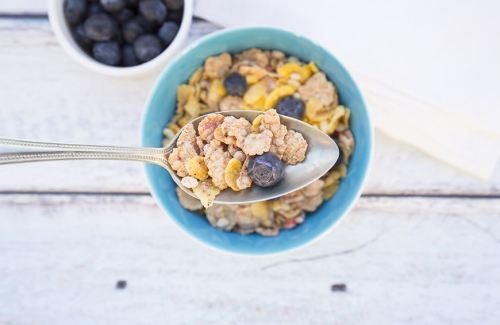Our editors independently select these products. Making a purchase through our links may earn Well+Good a commission
Cereal is a killer—of your healthy #goals. And we’re not just talking about Lucky Charms: Along with the touted nuts and grains, many of the healthy-looking brands are secretly chock-full of sugar and preservatives.
That’s why many nutritionists, including Kasia Michalski, founder of EatFit and an ACE certified lifestyle and weight management coach, say to avoid the breakfast staple if you’re trying to be healthy or lose some weight.
“Cereals are typically loaded with sugar, low-quality carbs, and unnecessary hydrogenated oils.” —Kasia Michalski, certified lifestyle and weight management coach
“Cereals are typically loaded with sugar, low-quality carbs, and unnecessary hydrogenated oils,” says Michalski. And, of course, they’re highly processed.
If pressed to name some good choices, Michalski likes Food for Life Ezekiel Organic Sprouted Whole Grain Cereal (Almond, Golden Flax, or Original), Cascadian Farm Organic Multi Grain Squares Cereal, and good old-fashioned steel-cut oatmeal—”the safest way to go,” she says.
But try to keep your serving size small—perhaps demote cereal to garnish status by sprinkling two tablespoons over fruit or yogurt.
Want to know if your favorite cereal is sneakily not very healthy? Here are 5 things to look for:
1. Beware of oils. Not just hydrogenated oils (or trans fats), but also olive oil, which can super-size the calories. Granola, we’re talking to you.
2. Look for a high fiber content (5 grams or more), and high protein content (from organic soy, nuts, and seeds). These cereals will digest more slowly and keep you satiated longer.
3. Look for low sugar content (less than 5 grams is good, less than 2 is ideal). Kashi Go Lean Crunch, by comparison, has 13 grams. And skip those with dried fruit, which can amp up the sugar calories, and add real fruit to your cereal instead.
4. “Organic” doesn’t mean “healthy” or “not fattening.” Organic canola oil is still canola oil and can still be hydrogenated. Organic sugar is still sugar.
5. Consider the quality of the ingredients, not just the calories. If there is more fiber, low sugar, little to no oil, then there will naturally be fewer calories.
This story was originally published on October 7, 2011; it was updated on July 23, 2018.
Sign Up for Our Daily Newsletter
Get all the latest in wellness, trends, food, fitness, beauty, and more delivered right to your inbox.
Got it, you've been added to our email list.











